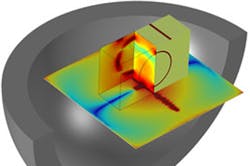Dielectric Resonator Antennas Conquer Microstrip Issues in mm-Wave Apps
At millimeter-wave frequencies, microstrip antennas can suffer from both high conductor and substrate losses, thereby deteriorating antenna radiation efficiency. To solve this problem, lossy planar metallic antennas can be replaced with high-permittivity dielectric resonator antennas (DRAs). Fabrication of a DRA would involve a silicon or gallium-arsenide (GaAs) substrate. To demonstrate, a group of researchers from Egypt, Saudi Arabia, and Belgium introduced a cylindrical DRA that’s suitable for millimeter-wave on-chip applications. The proposed DRA is fabricated from a single high-resistivity silicon wafer via micromachining technology.
The geometrical parameters of the proposed structured were optimized using ANSYS’s High Frequency Structure Simulator (HFSS) software. Subsequently, six-inch, double-sided, polished, high-resistivity silicon wafers were used to fabricate the DRA. The measured return-loss values demonstrated agreement with the simulated results.
The DRA’s measured resonance frequency was 59 GHz, which was close to the simulated value of 59.5 GHz. A 10-dB impedance bandwidth of 2.23 GHz was achieved, equating to 3.78% at 59 GHz. Average gain was about 6.5 dBi across the bandwidth, with a gain of 7 dBi at the resonance frequency. In addition, a radiation efficiency of 79.35% was achieved at 60 GHz. See “Micromachined On-Chip Dielectric Resonator Antenna Operating at 60 GHz,” IEEE Transactions on Antennas and Propagation, August 2015, p. 3410.
